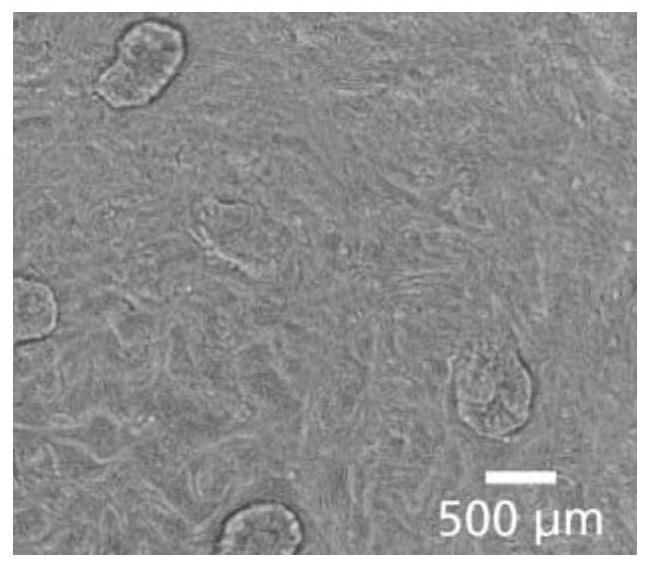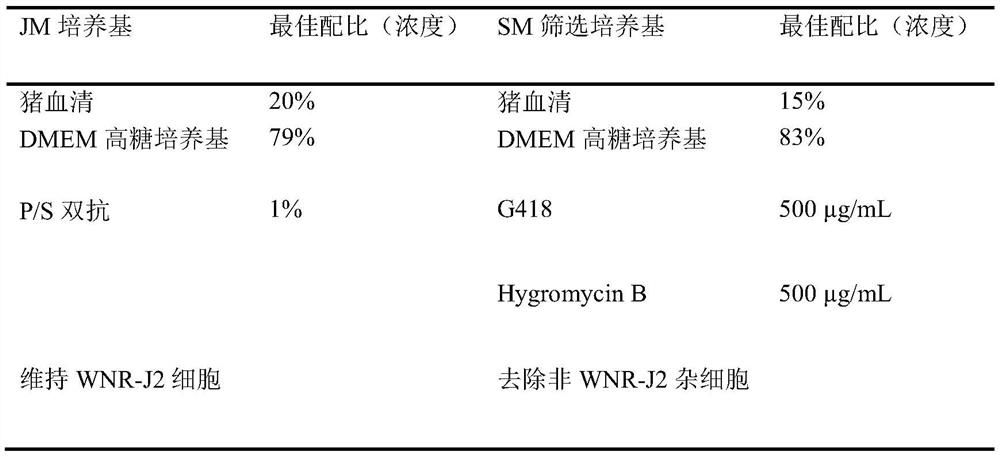Molecular culture medium for culturing small intestine organoids of pigs
A medium and organoid technology, which is applied in the field of molecular medium for culturing porcine intestinal organoids, can solve the problems of easy apoptosis, inability to differentiate, and prone to swelling, and achieves high specificity, stable repeat effect, and high plasticity. Effect
- Summary
- Abstract
- Description
- Claims
- Application Information
AI Technical Summary
Problems solved by technology
Method used
Image
Examples
Embodiment 1
[0040] 1. Preparation of WNR-J2 Conditioned Medium
[0041] The components of JM medium and its selection medium are listed in Table 1.
[0042] Table 1
[0043]
[0044] The preparation steps of WNR-J2 conditioned medium are as follows:
[0045] (1) Preparation of JM medium: Add 100 mL of thawed pig serum (Porcine Serum, Gibco, 26250084) at about 4 °C to 395 mL of DMEM high-glucose medium (SIGMA, D6429), and then add 1% penicillin / streptomycin Double antibody (Penicillin~Streptomycin, Gibco, 15140122) is 5mL, mix thoroughly, and store at 4°C for later use;
[0046] (2) Take 10 mL of JM culture, preheat it in a 37°C water bath, and then transfer it to a T25 culture flask;
[0047] (3) Thaw WNR-J2 cells quickly in a water bath at 37°C, rotate the cryopreservation tube clockwise to melt, and stop the water bath when only soybean-sized ice cubes remain;
[0048] (4) Quickly transfer the cell solution to a T25 culture flask containing medium, at 37°C, 5% CO 2 Incubator, un...
Embodiment 2
[0073] Example 2 Isolation of crypts in different intestinal segments of weaned piglets and culture of 3D organoids
[0074] In this example, the basic molecular medium was used, prepared according to the proportion of 50% WNR-J2 conditioned medium and the recommended molecular concentration, without adding any inhibitors, and only adjusting the pH value to the recommended range for different intestinal segments.
[0075] (1) Thaw Matrigel on ice, the specific amount can be adjusted according to the actual situation. Preheat the TC 24-well culture plate in the cell culture incubator for at least 30 minutes;
[0076](2) Take 10 cm sections of duodenum, jejunum, and ileum of weaned piglets, cut them open and wash them with saline immediately, add 5 mL of cold (2-8°C) DPBS to a 10 cm round petri dish, and put them into the intestines. Use a glass slide to scrape off the fluff, then re-add 5 mL of cold DPBS, scrape off the crypt vigorously, and discard the smooth muscle layer. T...
PUM
 Login to View More
Login to View More Abstract
Description
Claims
Application Information
 Login to View More
Login to View More - R&D
- Intellectual Property
- Life Sciences
- Materials
- Tech Scout
- Unparalleled Data Quality
- Higher Quality Content
- 60% Fewer Hallucinations
Browse by: Latest US Patents, China's latest patents, Technical Efficacy Thesaurus, Application Domain, Technology Topic, Popular Technical Reports.
© 2025 PatSnap. All rights reserved.Legal|Privacy policy|Modern Slavery Act Transparency Statement|Sitemap|About US| Contact US: help@patsnap.com



